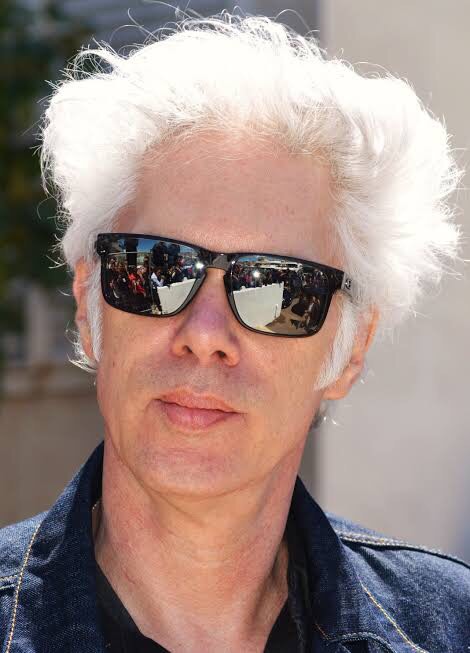
Jim Jarmusch, who are you? "If aliens watched us make a film, they would think we were ridiculous," - Jim Jarmusch, the New York Times, 1992 In one episode of the Simpsons, they meet Jim Jarmusch to ask him who he is. He replies that he tries to answer that question in his films. So, watching Jim Jarmusch’s films may lead the viewer to understand who he is. Who could that be? A loner, a poet, a musician, a socially-awkward artist, reluctant to the spotlight, determined to create art as long as it takes him, a stranger, a philosopher, and a spiritual creation. All this is obvious, but who is Jim Jarmusch anyways? He is a weirdo who embraces weirdness to the fullest. All comments and descriptions of him emphasize the halo that surrounds him everywhere. Longtime friend Tom Waits called him, “The key, I think, to Jim, is that he went gray when he was 15 … As a result, he always felt like an immigrant in the teenage world. He’s been an immigrant — a benign, fascinated foreigner — ever since.” Juan A. Suárez described Jim Jarmusch in one of the Contemporary Film Director book series. He wrote that Jarmusch was: "An endearing eccentric slightly at odds with his surroundings whose presence is at once self-effacing and subtly pervasive". Jarmusch enjoys odd pairings of people who sometimes can’t communicate what and how they feel because they either speak a different language or their backgrounds are entirely different. Isn’t this Jarmusch trying to communicate with people all his life? He is trying to be understood by a world that rarely understands him and treats him with caution, probably leaving the sign “Handle with Care” taped to his forehead. Jarmusch is not concerned with film time. He wants to approximate real-time as much as possible, whether in an awkward café, a room where someone spends too many nights playing guitar, a bus route, or woods mimicking Purgatory. Jarmusch tries to decipher the time code and what it means in real life or on screen. His films are long shots of people breaking the ice of distant relationships and communication methods that miss the spot. Is he simply a filmmaker or a true artist? How does that show in his movies? French and Japanese cinema has had a significant influence on Jarmusch. It shows in his deep interest in character analysis and the use of black and white. Jarmusch’s movies are minimal and austere, strangers on a strange land where nothing is hospitable or inviting. Nothing seems familiar, not the Lower East Side, not Detroit, not Tangier, and not the western town Machine. He is deeply affected by film noir where the traces of a mysterious story where goodness or badness doesn’t matter shows in most of his films. There is no classic good guy/bad guy in a Jarmusch movie, even the ones minding their own business may face a situation where their morality is tested. Still, they don’t end up as heroes or villains but merely humans counting their steps and making the necessary movie one at a time. Jarmusch is not concerned with breaking that eerie feeling of otherness. He embraces otherness in his films through his protagonists or -more or less- the lack of an actual hero on whom to build a film. He is fascinated by musicians and music. It is his source of inspiration as most of his movies seem like meditative pieces on life, like lengthy guitar solos or jazz improvisations. Viewers don’t feel his films are meticulously-structured narrative-wise, although his command of the technique shows. Listening to actors talk about Jim Jarmusch shows how they feel that it is genuine and unrestrained to be working on a Jim Jarmusch film. Tilda Swinton called it “like Christmas every day”. Johnny Depp described him as “one of his best friends”. Austin Butler mentioned how he discussed red carpet style with him. Iggy Pop explained how trusting he was of Jarmusch’s artistic choices that he asked him to make a movie about The Stooges regardless of his appearance in it. In his interviews, Jarmusch speaks slowly, taking his time with answers and elaborations. It doesn’t seem like he is in a hurry, and he seems oblivious to the surroundings, the crowd and the attendees matter least to him, and neither does the one interviewing him or engaging him in a discussion. With Jim Jarmusch, one becomes in Jim Jarmusch's land, where senses collide and coalesce to create a feeling and evoke emotion in the viewer. However, sometimes, Jarmuschian films may not need to be watched. They can be music compositions on their own. The music takes centerstage more times than often, with soundtracks ranging from grungy electric guitars to ambient electronic music relying heavily on analog synthesizers. For Jarmusch, music comes first. A love for a musician or a sound could build an entire movie, which is why his films might seem strange without the soundtrack context. His movies are not for the people who cannot immerse themselves in an artistic experience. But since movies have differed gravely in context and content from before, this eccentric artist has seen a surge in popularity with younger audiences who may or may not be looking for a way to disconnect from the average top 10 on a streaming service experience. Jim Jarmusch may have been the rockstar of American indie filmmakers, but an aloof one at that, the Thom Yorke of the scene, adding his musician status to the mix, Jarmusch chose a life of secrecy rather than bathing in the much-welcomed attention that stars and star makers revel. His identity remained the same throughout his career, and his state of weirdness proved not to be an act, but an authentic personality trait, as his films grew further apart and his filmography grew more eclectic. Although his latest film, “The Dead Don’t Die” is an asymmetric, sublime, zombie post-apocalyptic, star-studded tale, it still had some Jarmusch-ian elements. A collector of music, photographs, poetry, and people before starting any project, Jarmusch is the American hunter, going out on expeditions to capture gems that pass unnoticed by others, dismissed as mundane. He is the ultimate hoarder, but a poetic one at that. His career in retrospect was not concerned with the aesthetic star beauty of charisma. “Stranger than Paradise” and “Down by Law” had more unknowns than known actors. Iggy Pop made more than one appearance in a Jarmusch movie, and Yasmine Hamdan appeared in a magical scene to steal the spotlight from Tom Hiddleston and Tilda Swinton. The thing with Jarmusch is that he experiments with actors all the time. He allows them to surprise him. He retains that curious kid fascinated by art deep and doesn’t let go in favor of the director’s ego. Jarmusch dismisses the traditional storytelling structure. Like a jazz musician, he improvises, creates scenes on the spot, and changes dialogue constantly. The ending result is a bit chaotic but within a frame of synchronicity. His style doesn’t overshadow his characters’ triumphs and misgivings, lost as they are in big cities, woods, or within the walls of their own homes, they go on aimless journeys not to follow a dream or set on a hero’s route, like the flow of the river, as they move, stillness would only mean stagnancy and Jim Jarmusch is by no means a static artist.

Jaylan Salah Salman is an Egyptian poet, translator, two-time national literary award winner, animal lover, feminist, film critic, and philanthropist.
She received her BSc in pharmacy in 2011, and has published film criticism articles, short stories, poems, and translations in many websites and offline publications such as “Al Ahram”, “Vagues Visages”, “Synchronized Chaos”, “The Gay Gaze”, “Cinema Femme Magazine”, ” Eye on Cinema” and “Guardian Liberty Voice”. Her first short story collection, “Thus Spoke La Loba”, was published in 2016 by the Egyptian Supreme Council of Culture. Her first poetry collection in English, “Work Station Blues”, was published by PoetsIN, a British publishing house with the purpose of destigmatizing mental illness and supporting international artists. Her debut novel “Bogart Play me a Classic Melody” has made wide critical acclaim and was recently chosen as one of the 32 novels in the “Arab Voices” initiative at the virtual Frankfurt Bookfair in 2020. Her second poetry book “Bury my Womb on the West Bank”, was published in 2021 by Third Eye Butterfly Press and available on Amazon in both ebook and paperback formats. Her second novel “Rita’s Dance” was published in 2022 by Noon for Publishing and available for purchase both in paperback and ebook formats.
